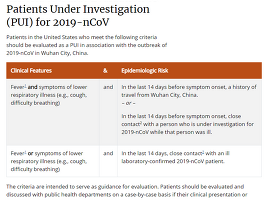Novel coronavirus in Wuhan, China

중국 후베이 도시인 우한에서 폐렴의 원인으로서 신종 코로나바이러스가 확인되었습니다.
2020년 1월 중국에서 수 백 건의 검사실 확진 케이스가 보고되었고 대부분 중국에서 보고되었지만 우한 지역을 여행한 사람들 가운데 산발적 보고가 태국, 일본, 한국, 미국에서 있었습니다.
A novel coronavirus was identified as the cause of a cluster of pneumonia cases in Wuhan, a city in the Hubei province of China, at the end of 2019. By late January 2020, hundreds of laboratory-confirmed cases in China had been reported, and the case count has been rising daily; most reports are from the Hubei province, but several cases have been reported in other municipalities in China, including Beijing. Scattered cases among travelers from Wuhan have also been reported in other countries (including Thailand, Japan, the Republic of Korea, and the United States [Washington state and Illinois]).
발열, 호흡곤란, 흉부 엑스레이에서 폐하부 침윤을 특징으로 합니다. 많은 케이스들이 중증은 아니지만 상당한 소수에서 호흡부전, 패혈성 쇼크, 장기부전을 포함한 중증 증상을 나타냈습니다. 대부분의 치명적 케이스들은 기저 의학적 질환이 있는 환자에서 발생했습니다.
The cases are characterized primarily by fever, dyspnea, and bilateral infiltrates on chest imaging, but full clinical information is not yet available. Although many of the reported infections are nonsevere, a substantial minority of patients have had critical illness (including respiratory failure, septic shock, or other organ failure requiring intensive care). Most of the fatal cases have occurred in patients with underlying medical comorbidities.
모든 케이스들이 시장 관련성이 있는 것이 아니었으며 의료진들 가운데 케이스가 보고되었으므로 사람-사람 전염을 나타냅니다.
Epidemiologic investigation in Wuhan identified an association with a seafood market where most patients had worked or visited and which was subsequently closed for disinfection. The seafood market also sold live rabbits, snakes, and other animals. However, not all laboratory-confirmed cases had contact with this market, and cases have been reported among health care workers, indicating human-to-human transmission.
The World Health Organization (WHO) is not recommending special travel restrictions; however, it advises travelers to Wuhan to avoid contact with live or dead animals and sick individuals and to practice diligent hand hygiene. On January 22, health officials in China announced a restriction of public transportation within and a halt of air and rail traffic out of Wuhan and surrounding areas. In the United States, airports in some major cities (including San Francisco, Los Angeles, and New York City) had begun screening air travelers from Wuhan for signs of illness on arrival.
① 중국 우한 지역에 살고 있거나 ② 최근에 이 지역으로 여행을 하였거나(14일 이내) 이 질환에 확진되었거나 이 질환에 의심된 사람과 ③ 밀접하게 접촉한 사람에서 발열 그리고/또는 하부 호흡기 증상이 있는 경우에 이 코로나바이러스 가능성을 고려해야 합니다.
The possibility of this novel coronavirus should be considered in patients with fever and/or lower respiratory tract symptoms who reside in or have recently (within the prior 14 days) traveled to the Wuhan area of China or who have had recent close contact with a confirmed or suspected case of novel coronavirus. When novel coronavirus is suspected, infection control measures should be implemented and public health officials notified. In the United States, the Centers for Disease Control and Prevention (CDC) recommends a cautious approach to infection control in the clinical setting and advises standard, contact, and airborne precautions as well as eye protection. In addition to testing for other respiratory pathogens, the CDC recommends collection of specimens from the lower respiratory tract (sputum, tracheal aspirate, or bronchoalveolar lavage), upper respiratory tract (nasopharyngeal/oropharyngeal swab or nasopharyngeal wash), and serum. Novel coronavirus is detected by polymerase chain reaction; in the United States, testing is performed through the CDC. Management of documented cases consists of supportive care.
Ref. UpToDate 2020.01.26
'감염내과 > 기타' 카테고리의 다른 글
| 2019-nCoV 감염에 대한 조사 대상 환자의 CDC 임상 기준 (0) | 2020.02.05 |
|---|---|
| Coronavirus, 코로나바이러스 (0) | 2020.01.29 |
| 2019 신종 코로나바이러스, 의심환자 기준, 2019-nCoV, PUI(Patients Under Investigation) criteria, 2020.01.26 (0) | 2020.01.26 |
| 아데노바이러스, 임상 증상, Adenovirus, clinical presentation (0) | 2019.11.24 |
| 광견병(공수병), 노출 후 예방, Rabies, post-exposure prophylaxis(PEP) (0) | 2019.11.04 |


